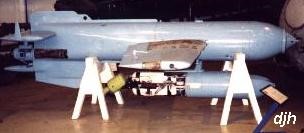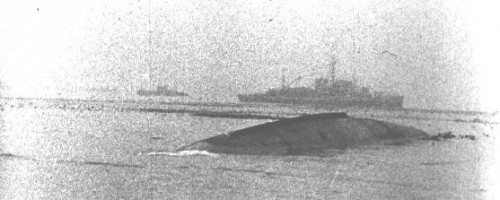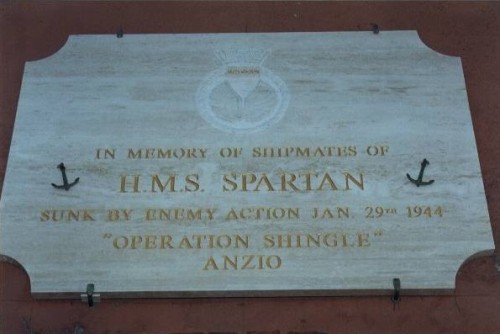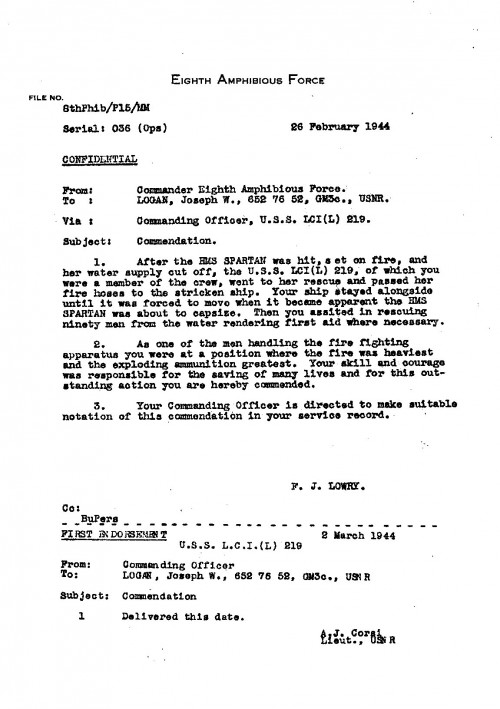The Loss of HMS Spartan 29th January 1944
THE LOSS OF HMS SPARTAN 29th JANUARY 1944
At sunset on 29th January, the Luftwaffe began a glide bomb attack on the ships in Anzio Bay. At the time of this attack, HMS Spartan was anchored providing AA protection for the ships in the vicinity of the beachhead. Smoke had been ordered in the anchorage but was not fully effective owing to the short time it was in operation and the strong breeze. HMS Spartan was making smoke from stem to stern but was not herself covered.
About 18 aircraft approached from the north and circling over land, delivered a beam attack against the ships that were silhouetted against the afterglow. The timing of the attack prohibited the aircraft from being sighted except by very few witnesses, and radar was ineffective owing to land echoes. By the time the warning had been received and HMS Spartan and other ships had opened fire in the general direction of the attack, six bombs were already approaching the anchorage, most of them falling into the water.
Shortly afterwards, at approximately 17:56, another glider bomb (radio-controlled Henschel Hs 293) was seen approaching the starboard side of the ship. This bomb was engaged by close range anti-aircraft fire; it was first thought likely to miss astern but is reported to have altered course during the final stage of its approach.
The bomb struck the ship at the after end of “B” funnel casing, started a heavy fire in the vicinity, the projectile passed through the ship and exploded high up on the port side of the main watertight sub-division containing “B” Boiler Room.
The main mast collapsed and boiler rooms were flooded. Steam and electrical power failed, a serious fire developed and the ship heeled over to port. Thus HMS Spartan was immobilized. About an hour after being hit, Spartan had to be abandoned in the dark, and 10 minutes later she settled on her beam-ends in about 25–30 ft (7.6–9.1 m) of water.
Five officers and 41 enlisted men were posted killed or missing presumed killed, and 42 enlisted men were wounded. Ron Douglas survived together with Acting Lieutenant J.S. Mackonochie, engineer.
The following extract is from Ronald Sired’s book, “Enemy Engaged” (published by William Kimber & Co. London, 1957, page 184) who was serving onboard HMS Laforey.
Just about this time I spotted a radio controlled-rocket bomb coming from a Do.217, and heading straight for Spartan. All our close-range weapons were directed towards the bomb, but it was travelling too fast for our fire to be accurate. I was able to see its red tail as it made for Spartan some 400 yards away. I watched helplessly as the bomb fell. I saw a bright flash as it exploded amidships, between the funnels, and a pillar of flame shot into the evening sky, momentarily lighting up Spartan. Serious fires were started and the Spartan quickly listed to port. By 1800 (this time must be incorrect as it does not fit with the Admiralty report) she was badly ablaze and, as the flames grew higher, I saw men dashing along her heeling decks with hoses and other fire fighting equipment. Other men dived over the side into the water.
Laforey moved closer to the strickened ship, which had listed further to port. Already her stern was below water. The after turret glowed red hot and sultry red flames reflected from gathering clouds. Laforey lowered both whalers and the motor-boat to pick up survivors. HMS Barndale was also standing close by, ready to go alongside Spartan at first opportunity to take off the wounded menbers of her ship’s company.
By 1840, the Spartan had listed some 70 degrees to port and I saw loose gear from her upper deck fall into the sea. Most of her ship’s company had jumped overboard and were being picked up by small craft. Her list increased and her fires died down as water flooded her compartments. From across the still waters came cries of men as they struggled in the oil-covered waters. The faint glow of torches flickered here and there as boats made their way to them.
By 1910, Spartan lay almost on her beam-ends and the water was lapping around her bridge. There were still a few intrepid sailors aboard her, helping wounded men to the boats alongside. Our motor-boat came alongside and took off her skipper, Captain McLaughlin. I saw a small cockle shell of a boat, a dinghy, containing one sailor, bobbing up and down close to the compass platform of the cruiser, searching for survivors. It was a queer sensation to watch the sea claim this once proud ship. The sea lapped over the upper-deck, which was now practically vertical and facing towards me.
By 1930, our scrambling nets which had been lowered over the side were swarming with oil-soaked survivors, and the first-aid and repair parties assisted them as they climbed inboard. There was considerable activity on board as the damage control parties dashed away for rum and blankets. Most of our ship remained closed-up in case of further attacks, but there were none.
By 1940, Spartan’s bridge and upperworks were underwater and I watched her starboard bilge keel appear as she slowly rolled over. The sea broke over her keel and her rudders and propellers were clearly visible as she sank from sight. By 2000 Spartan was no more. I had watched the foaming waters surge over her keel as she vanished, (In reality it was probably the darkness and not the sea that swallowed Spartan for, in fact, the ship’s keel remained visible).
The task of searching for her crew continued in the darkness and, as our mess-decks were crowded with survivors we moved away from the scene. Landing craft came alongside Laforey to take off Spartan’s survivors and at 2030, with the destroyer Loyal, we left for a night patrol at sea.
Joseph Logan, Gunners Mate, on board LCIL 219, together with his shipmates also assisted HMS Spartan. As Joseph described it, “LCI 219 quickly pulled alongside the Spartan in an effort to assist fighting the fires. I was manning one of the hoses. The landing ramps of the LCI were lowered down to the water surface to assist pulling the sailors out of the water. Other crew members of LCI 219 helped the Spartan sailors up the ramps. I seem to remember there were about 75 men pulled out of the water onto LCI 219. First aid was provided as needed.”. His son states that his father and other crew members used artificial respiration methods that he learned in the Boy Scouts to aid some of the British sailors.






My grandfather’s youngest brother Edward Victor Pegler from Colwyn Bay was killed on the Spartan. He had been a cook on board and it was said that he had had a premonition before he went that he wouldn’t be coming back.
My grandfather George Roycroft jumped off or went down with the hms spartan . Didnt say much other than just a lil about the atom bomb and how it worked aparantly dropped thru all floors and exploded in the water , also said he spent 17 hours in the water with a rubber ring, he couldnt swim but was in the navy he chuckled .. Blows my mind what these brave men went through.i would love to find out more about his time in the water and who picked him up. I have nothing but respect for all on board.
Hello, My Uncle Bill (W. B. Smith) was a (newly made up PO) Radio Mechanic who went down on HMS Spartan, aged 20. I helped David Hughes with information for his wonderful web site (because he lives in NZ.). I will post here again with more information. The ships log, damage report and board of inquiry report (6 months worth) are available at Kew Public Records Office. I obtained plans of the ship and photos from the ship builders. The Imperial War Museum has a bit of film taken from Spartan, and a very brief bit of Spartan after she was hit. They also have German training film of the glider bomb.They have photos of Spartan and of the Captain, and Commander Ambrose. I did about 15 or 16 sound interviews with Spartan Survivors which are lodged in their Sound archive – some are online to listen to. I did one with a soldier who was on the land. Search the sound archive by “HMS SPARTAN” and “Patricia Smith”. I hope to write to the university that hosted David’s website to ask what happened to it. It meant so much to us all. I also have letters containing memories, written to me by sailors who survived and soldiers who were on land, written to me in around 1997 and after. I was in contact with people like Ron Douglas, Johnny Joseph, and George Busby, Geoff Smith, Dennis Brownhill, Mrs Stitt … etc. Best wishes to you all. Pat.
Sorry I meant six months worth of the ships log.
David Hughes’ website address was, I think:
http://home.aut.ac.nz/staff.dhughes
I have received this response back from AUT:
(The website is PARTLY captured on Wayback Machine.)
“Kia ora Patricia
Thank you for getting touch.
This site wasn’t an AUT site managed by our Brand and Marketing website team.
It seems to have been a personal staff site. One of our team members has used the Wayback Machine to find a version of the site from 2014, at this link below:
http://web.archive.org/web/20140531201020/http://home.aut.ac.nz/staff/dhughes/
I hope that is helpful.
Ngā mihi”.
Hi Pat
I last heard from David Hughes in 2015 – he had retired and seemed to have many projects on the go but was thinking about resurrecting the website.
I have downloaded everything using the link above plus I think I have print dumps so might be able to piece together the website thenit should be possible to bring it back to life
I have emailed David and hopefully he will respond
By the way which university was he at?
Regards
Charles Mackonochie
How strange, the link didn’t paste.
In my previous posting – try clicking on the space where it should have pasted to.
Re-trying:
http://web.archive.org/web/20140531201020/http://home.aut.ac.nz/staff/dhughes/
My father, PO(W) Gerry Crocker served on Spartan. Very badly concussed in attack & burnt hands badly. He helped rescue shipmates in water (he was a very strong swimmer) & was rescued by a USN Landing craft, ramp down. Was awarded BEM. Died aged 97 at Sidford, Devon, on 31 Dec 2017. Apparently was penultimate survivor (last survivor died a few months later).
Hi Pat
I last heard from David Hughes in 2015 – he had retired and seemed to have many projects on the go but was thinking about resurrecting the website.
I have downloaded everything using the link above plus I think I have print dumps so might be able to piece together the website thenit should be possible to bring it back to life
I have emailed David and hopefully he will respond
By the way which university was he at?
Regards
Charles Mackonochie
Sir I have a ww2 issue slip to a D/SSX2245 a William McCarthy WHO WAS LOST When H.M.S. Sultan went down i checked the commonwealth war graves but no relatives or address of where he camee from how can i find this out regards Mick Gray